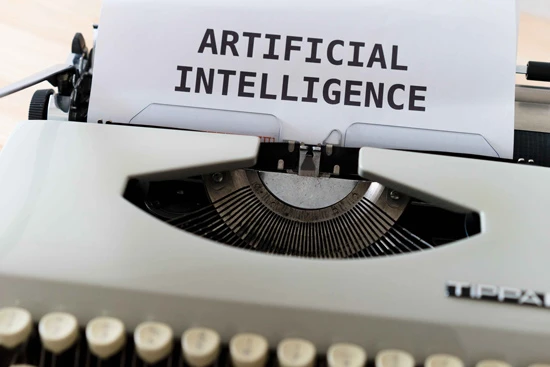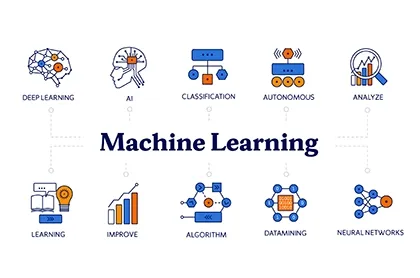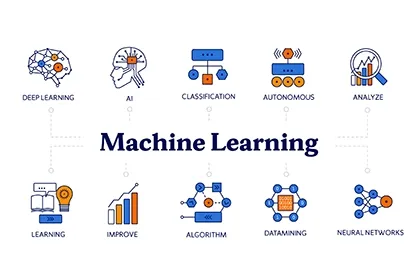A History of Artificial Intelligence
The term artificial intelligence was coined in 1956, but AI has become more popular today thanks to increases in data volume, advanced algorithms, and computing power and storage.
Early AI research in the 1950s explored topics like problem solving and symbolic methods. In the 1960s, the U.S. Department of Defense became interested in this type of work and began to explore the use of computers to mimic human reasoning. For example, the Defense Advanced Research Projects Agency (DARPA) finished street mapping projects in the 1970s.
This early work laid the foundation for the automation and formal reasoning we see in computers today, including decision support systems and intelligent search systems that can be designed to complement and augment human capabilities.
While Hollywood science fiction movies and novels portray AI as human-like robots taking over the world, current developments in AI technologies aren’t quite so scary or sentient. Instead, AI has evolved to provide many specific benefits across every industry. Continue reading for modern examples of AI in healthcare, retail, and more.
Artificial Intelligence and Machine Learning
Quick, watch this video to understand the relationship between AI and machine learning. You’ll see how these two technologies work, with examples and some interesting tidbits.
Plus, it's a great video to share with friends and family to explain AI in a way everyone will understand.
Why is AI Important?
- AI automates repetitive learning and discovery through data. But AI differs from robotic process automation (RPA). Instead of automating manual, repetitive, high-volume tasks, AI performs computer-based tasks reliably and tirelessly. For this type of automation, human inquiry is still essential to set up the system and ask the right questions.
- AI adds intelligence to existing products. In most cases, AI isn’t sold as a standalone application. Instead, products you already use are improved with AI capabilities, much like Siri was added as a feature to a new generation of Apple products. Automation, conversational platforms, bots and smart machines can be combined with vast amounts of data to improve many technologies at home and work, from security intelligence to investment analysis.
- AI adapts through progressive learning algorithms so that data can do the programming. AI finds structure and order in data to acquire algorithmic skill: the algorithm becomes a classifier or a predictor. So, just as an algorithm can teach itself how to play chess, it can teach itself which products to recommend online. And models adapt as new data is provided. Backpropagation is an AI technique that allows the model to adjust through training and added data, when the first answer isn’t quite right.
- AI analyzes larger and deeper data using neural networks that have many hidden layers. Building a fraud detection system with five hidden layers was almost impossible a few years ago. Everything has changed with incredible computer power and big data. You need a lot of data to train deep learning models because they learn directly from data. The more information you give them, the more accurate they become.
- AI achieves incredible accuracy through deep neural networks — previously impossible. For example, your interactions with Alexa, Google Search, and Google Photos are all based on deep learning — and the more we use them, the more accurate they become. In medicine, AI techniques from deep learning, image classification, and object detection can now be used to find cancer in MRIs with the same accuracy as highly trained radiologists.
- AI makes the most of data. When algorithms are self-learning, data can become intellectual property. The answers are in the data; you just need to use AI to pull them out. Since the role of data is now more important than ever, it can create a competitive advantage. If you have the best data in a competitive industry, even if everyone is using similar techniques, the best data will win.
How is AI Used?
Every industry has a high demand for AI capabilities — especially question-answering systems that can be used for legal assistance, patent searching, risk informing, and medical research. Other uses of AI include:
Healthcare
AI applications can provide personalized medicine and radiology readings. Personal healthcare assistants can act as life coaches, reminding you to take your pills, exercise, or eat better.
Retail
AI provides virtual shopping capabilities that offer personalized recommendations and discuss purchasing options with the consumer. Inventory management and site layout technologies are also improved with AI.
Manufacturing
AI can analyze factory IoT data from connected equipment to predict expected load and demand using recurrent networks, a special type of deep learning network that uses sequential data.
Banking
AI enhances the speed, accuracy, and effectiveness of human efforts. In financial institutions, AI techniques can be used to identify fraudulent transactions, provide fast and accurate credit scoring, and automate intensive data management tasks.





